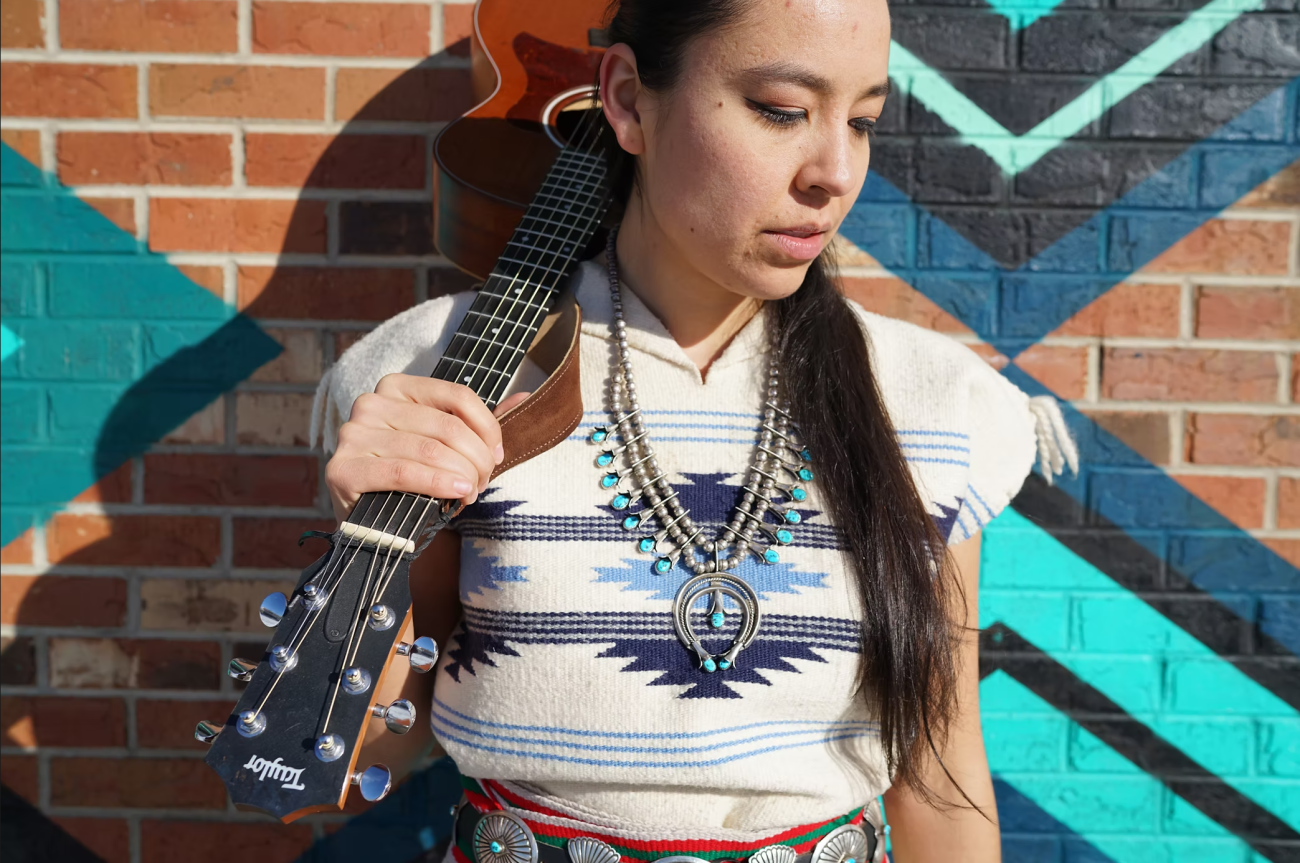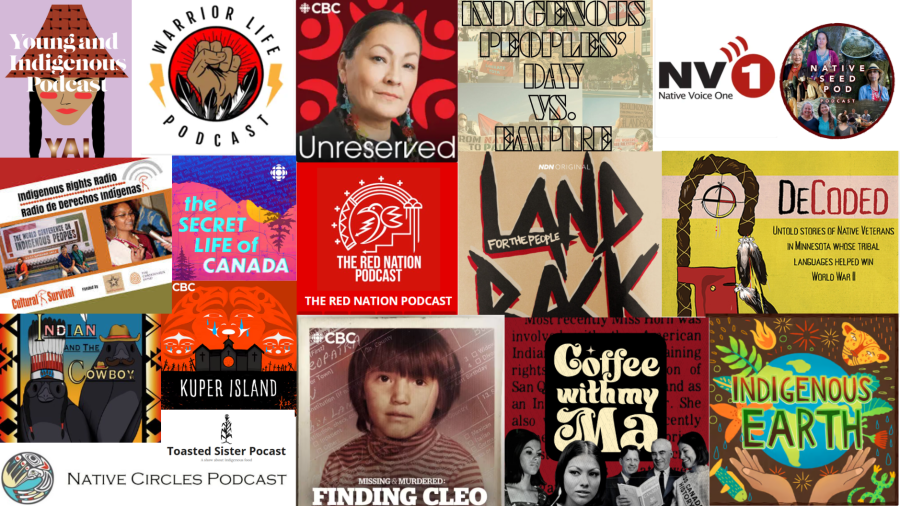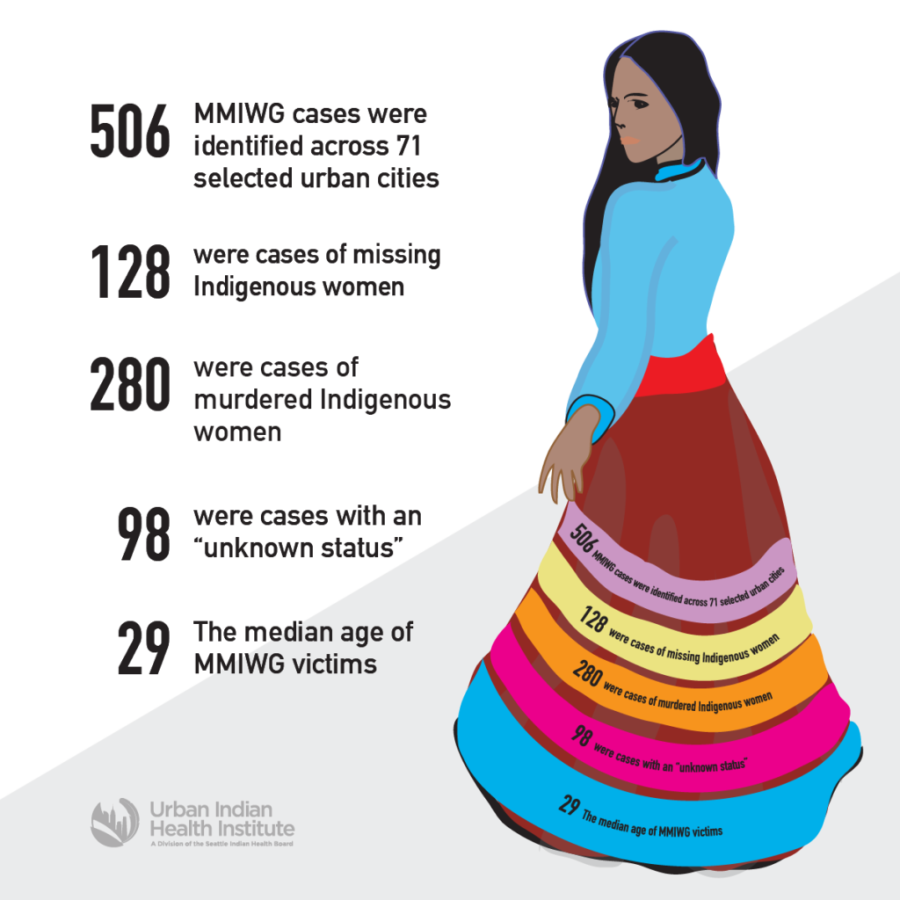
Cultural Survival welcomes the newest member of our Board of Directors, Dr. Lyla June Johnston. Lyla June is an Indigenous musician, author, and community organizer of Diné (Navajo), Tsétsêhéstâhese (Cheyenne), and European lineages. Her multi-genre presentation style has engaged audiences around the globe towards personal, collective, and ecological healing. She blends her academic work in Human Ecology and Indigenous Pedagogy with the traditional worldview she grew up with to inform her music, perspectives, and solutions. Her doctoral research focused on the ways in which pre-colonial Indigenous Nations shaped large regions of Turtle Island to produce abundant food systems for both humans and non-humans. Indigenous Rights Radio Coordinator Shaldon Ferris (Khoisan) recently spoke with Lyla June about her work and passions.
Shaldon Ferris: Please tell us a bit about yourself.
Lyla June: I'm from the Naaneesht’ézhí T’ááchii’nii clan of the Diné Nation, also known as the Navajo Nation. I’m from Navajo country, as we call it, Diné Bikéyah—the People’s Land. We call ourselves “Diné,” which means “The People,” and we are Indigenous to what is now called New Mexico, Colorado, Arizona, and Utah—the southwestern United States, or Turtle Island. I have a Ph.D. in Indigenous land management techniques. As a musician, I like to make music that uplifts Indigenous voices and Indigenous themes. I’m also working to bridge cultures, because on my dad’s side, I am European. So, I try to bridge the western world and the Native world as much as I can to create peace, diplomacy, understanding, and to help us all heal from a lot of the challenges we’re facing as a species.
SF: How did you get into the fields of Human Ecology and Indigenous Pedagogy?
LJ: I think all Indigenous Peoples are human ecologists in the sense that we are all very connected to an ancient science of how humanity relates to the ecology of a given homeland. And yes, I did study Human Ecology at what my grandma calls the “White Man School,” at Stanford University. I did my master's in Indigenous pedagogy, which is basically about how Native people teach their children, how we reclaim education for ourselves, how we take control of our destiny as it pertains to education, and create our own schools, create our own training systems, or sometimes just revamp the old systems we always had.
I do really love to fight for Indigenous Peoples around the world because we all have beautiful sciences and we all have beautiful languages—and these languages, through trial and error, have really stood the test of time. Our ancestors learned not because they were perfect, but because they were imperfect. They made mistakes over thousands and thousands of years, and they learned through experience what works and what does not work, not only in terms of our food systems and government systems, but also in terms of gender roles and in helping women feel safe and protected.
I won't say all, but many Indigenous nations are co-led by women. They have no issue with women's leadership, and we’ve realized that this really works. A good way to sustain a civilization is to honor women, protect them, and let them have leadership positions. All of these things are what I try to lift up through my studies of human ecology, which are absolutely intertwined with our notions of spirituality, our notions of the sacredness of women, the sacredness of the Earth, and more. So, I got into it because I know that these things need to get out there into the world.
SF: Your TED talk got a lot of following. How have things changed for you since?
LJ: The TED talk is quite a big platform, and people seem to give it a lot of credence and prestige. But it's funny—they don't want to listen to my grandma and what she had to say. She's probably smarter than I am, but she doesn't have a TED talk. Our Elders are very wise, and they are worth listening to. It's kind of arbitrary that we choose this platform to be the thing that we all pay attention to.
I used this platform to elevate the message of how human beings can be a keystone species within an ecosystem. A keystone species is a species upon which entire ecosystems depend. I gave many examples of ways humanity has taken care of the land so well, so efficiently, so beautifully, that if we were to leave the system, the system would miss us; the Earth would miss us if we left. I gave concrete examples, such as how we restore bison habitat, create clam gardens, do farming in the desert, augment biodiversity, all these things.
I was trying hard to give people real-life examples of how humanity has been such a blessing to the Earth in the past. I was also trying to give hope that we can become that keystone species again while debunking the myth that humans are a virus or a pest, which many people have come to believe after witnessing what humanity has wrought on the Earth.
The response was positive. I got about 700,000 views on YouTube, which is pretty good. There are many TED talks with millions of views, but it's okay—I take what I can get. What I liked about it was not that it made me well known, but that it made our ancestors well known, that it made the message of our ancestors out there in the world. I did the whole speech wearing my traditional clothing, which is made from the wool of our sheep, and my traditional jewelry, which is our expression of spirituality. I represented my people with the clothing that we wear, and I liked that my People's beautiful clothing was amplified. That's what made me happy—not so much that my voice got out there, but that the voices of Indigenous Peoples got out there.
SF: In the talk, you drew a connection between healing the soil and healing Nations. Can you tell us more about this?
LJ: There's a lot of ecological healing that needs to happen, a lot of support for species where we, as humanity, can take all of the power we have and put it in service to things that are less powerful than us. We could use our power to lift up others: other species, birds, plants, trees, microbes—all the things that make up biodiversity. We can do that.
But in addition to healing ecology, we also have to heal society, and part of healing society is healing the past violence against each other, specifically against Indigenous Peoples. Part of the way we heal the theft of lands, the theft of labor, the theft of life itself through massacres and genocides, which absolutely occurred in the United States; nobody argues that there was a genocide here. They killed 98% of my people, all Indigenous Peoples in the United States were nearly annihilated.
In addition to healing the land, we have this glorious opportunity as a cross-cultural world to heal the wounds of social systems. When we heal and return land to Indigenous Peoples who have been dispossessed, we also heal the ecology. The two go hand in hand. When we heal history, heal the past trespasses against humanity, we can also heal the land. And when we heal the land, we heal the people.
SF: Who are some of your greatest role models?
LJ: My grandmother, Mitzy Bagey, is a big source of inspiration and learning because she does the womanhood ceremonies. In our culture, when a girl gets her first period, [we have] a four-day ceremony to celebrate her and to teach her how to be a woman. The way we teach her how to be a woman is to run in the morning, run in the evening, and to give to her people, to feed her people—not as a domestic role, but as a role of a warrior: the warrior who defeats hunger, cares for the children, and makes decisions on behalf of the Nation about how to care for the land.
In Diné culture, women are the leaders. We put a lot of investment in the girls when they get their first period. My grandma Mitzy, she has been doing these womanhood ceremonies for decades, helping the women know who they are. She’s a pillar of wisdom in our community. When young girls have their periods, they call her and ask, “What do we do? How do we do this?” She cares for the young women.
She also teaches the men how to do the manhood ceremony for young men, which happens when their voice starts to crack, teaching them how to be warriors for their People—how to be generous, how to be kind, how to think about others before you think about yourself, how to fight for your community, and how to be of service to humanity. That’s how you become a man in our culture.
We also take care of non-binary people, who don’t necessarily identify as male or female. We have space to honor them, too. My grandmother is my role model because even though she didn’t even graduate high school, she has a lot of knowledge, speaks our language fluently.
Secondly, in what we call the western world, I have a lot of role models. William Wilberforce is one—he fought tirelessly for decades for abolishing slavery in the United Kingdom and the British Empire. He fought very hard, from what I understand, to abolish slavery. He was a white man, but he gave his whole life to the abolition movement in the 1800s. I think we should always abolish all forms of hierarchy. For a white man to use his power and privilege within the House of Lords to fight for others is something that inspires me.
SF: What are some of the current projects you are working on?
LJ: I’m very fortunate to have had the honor of becoming a board member of Cultural Survival. They are a wonderful international organization that works to protect Indigenous Peoples unapologetically and has advocated for Indigenous Peoples for decades. The fact that you and I are talking as Indigenous Peoples—you from Africa, me from Turtle Island—is because of the network that they have woven of Indigenous Peoples around the world. I’m really excited and honored to be a part of this organization, and I deeply admire the grants that they give to Indigenous communities to do their work.
Other than that, I finished my Ph.D. and I’ve been working on a trade book—more like a popular science book, to explain these things to people so that anyone can pick it up, read, and enjoy. Writing it has been quite challenging because I’m used to writing academic papers, and now I have to write a story-based book to engage the reader, get them hooked into the story and want to finish the book. That’s been a challenge for me. This book is going to give many different examples of how Indigenous Peoples have cared for the land and the hope that this gives for our common humanity, the hope that says, “If these people do it, theoretically anybody can do it.” We can all remember how to be not a master of the Earth, but a servant of the Earth. That’s a big deal.
I also travel a lot. I give speeches all over the world. I’m going to the UK in a few weeks to speak at a few events. Other than that, I’m just trying to care for my endangered sheep, care for Mitzy, hang out with her as much as I can, and also trying to start a family. That’s what I’m up to.
SF: Why did you join the Cultural Survival Board? What are your hopes?
LJ: I want to support the work that they’re already doing. I want to support and be a servant to the system that they have worked to create, and hopefully bolster their work in whatever way I can, leveraging my platform to give voice to the work they are doing. I’ve been traveling with the magazines, pamphlets, and flyers, giving them to all of the communities I meet around the world and trying to represent Indigenous communities and their cause wherever I go.
My hope would be that we, as an organization, continue to normalize Indigenous leadership, not only in our respective countries, but globally. It’s absolutely time for Indigenous Peoples to step into leadership roles, where we help the world remember how to be human. And I think the more we can normalize and disseminate our messages, our principles, our strategies for healing the Earth and healing each other, the better. I think everyone will benefit—every single person, whether they’re white, Black, Native, Asian, Polynesian, Southeast Asian, Australian Aboriginal—all of us, and all the plants, and all the animals, and all the fungi, and all the microbial beings. We are all going to benefit from Indigenous leadership because that is the science of sustainability.
By definition, Indigenous Peoples are those who have stayed in one place for thousands of years. Those are the people who we ought to be learning from to become a sustainable society, a global society.
Top photo courtesy of www.lylajune.com.



